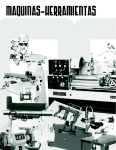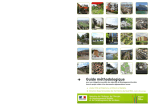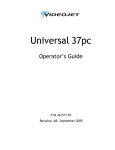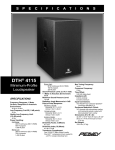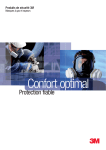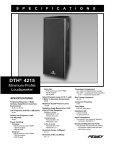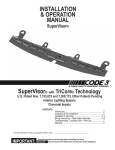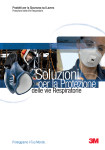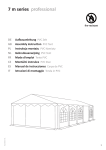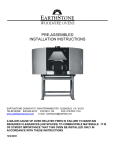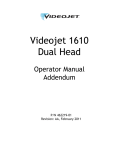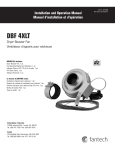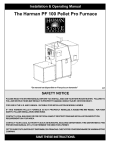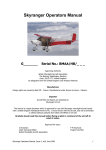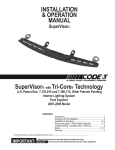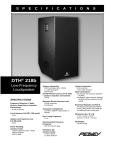Download VIDEOJET FOCUS S25
Transcript
VIDEOJET FOCUS S25 F I E L D C O M M U N I C AT I O N M A N UA L Table of Contents CHAPTER 1 - INTRODUCTION Overview 1 What is a laser 1 What are the S10, S25, and High Resolution printers 2 Why launch the new S25 and High Resolution printers 2 What is laser marking 2 What substrates can we mark 3 CHAPTE R 2 - PRODUCT INFORMA TION Overview 6 What is the Videojet Focus Steered Beam laser 6 When should I consider the High Resolution printhead option 9 Which focusing lens should I use 11 New software features 14 CHAPTE R 3 - SALES STRA TEG Y Overview 16 What are the features and benefits of the Videojet Focus S10 and S25 laser printers 16 Who are the target customers for EMEA and North America 17 Who are the target customers for the Asia Pacific region 18 Laser versus other technologies 19 Identifying a laser application 20 CHAPTE R 4 - LASER COMP ETITION Overview 22 U.S. based laser competition 22 Europe based laser competition 26 Asian based laser competition 30 CHAPTE R 5 - QUOTES AND ORD ER INFORMATION CHAPTE R 6 - PRODUCT CHAPTE R 7 - LASER SAFE TY 41 C H A P T E R 8 - LAS E R D A T A 43 INSTA LLATION S H E E T S PH OTOS 33 39 I N T R O D U C T I O N C H A P T E R 1 Overview V ideojet has extended our laser product line with the introduction of the Videojet Focus S25 and the High Resolution laser marking products. The new S25 and the High Resolution laser products build from the successful and proven Focus 1000 10w laser, now known as the Videojet Focus S10. This product overview is intended to provide sales personnel with knowledge on laser marking and Videojet’s laser products. This guide should help you understand your customer’s questions regarding laser marking. K E Y P O I N T S • What is a laser? • What are the S10, S25, and High Resolution printers? • Why launch the new S25 and High Resolution printers? • What is laser marking? • What substrates can we mark? • Sample Gallery Videojet Focus S10 Videojet Focus S25 What is a laser? The word laser is an acronym for “Light Amplification by Stimulated Emission of Radiation”. A laser tube is filled with gas that when excited with electrical energy, produces light energy or a laser beam. The lasers used by Videojet are of the CO2 (Carbon Dioxide) type, which falls into the infrared area of the light spectrum. Videojet Focus S series printers contain sealed Synrad CO2 lasers that output light energy at 10.6µm wavelength. VTI provides a 3-year warranty on the laser tube, guaranteeing that the laser tube power will remain at or above the specified systems specifications. 1 CONFIDENTIAL August 28, 2002 I N T R O D U C T I O N C H A P T E R 1 What are the S10, S25, and High Resolution printers? The MDS Focus 1000 has been re-branded as the Videojet Focus S10. We have rebranded to ensure that customers and prospects can easily, logically and clearly identify and assess our many product and service offerings. Additionally, we will leverage the Videojet brand name on all lasers products. Further, all new laser products will use a similar naming protocol that includes the Focus sub-brand. Accordingly, the new "Videojet Focus S25" name comprises the main brand and sub-brand, as well as a positioning indicator in the "family" of Focus lasers. The Videojet Focus S25 was developed based on the Videojet Focus S10 architecture. We have benefited from the intelligent and modular design of the Focus platform. The Videojet Focus S10 has become well established, with sales continuing to grow. The new S25 (25-watt) steered beam printer allows us to leverage the success, reliability and solid construction of the S10 (10-watt) printer. The High Resolution printhead is a new factory configuration for the Focus laser platform. As stated above, the Focus has a modular design that allows us to provide different printheads to customize our product for various applications. The High Resolution printhead includes special optics that provide a smaller spot size on the substrate being marked. The High Resolution printhead can be configured on both the S10 and the S25. We will discuss when to consider using the High Resolution printhead v. the standard printhead in the next section. High Resolution Print Sample 1 Why launch the new S25 and High Resolution printers? Videojet is committed to solving customers’ marking and coding needs. Accordingly, we must meet customers growing need for laser marking. The Focus S25 and the High Resolution printhead position Videojet with new laser products to solve more coding needs. The Videojet Focus laser platform will provide customers with the most reliable laser products and allow Videojet to be the single supplier for all coding needs. What is Laser Marking? Laser marking refers to marking by means of light energy. Energy is transferred from the laser beam to the substrate during the marking process. A mark is created through either the removal of material (vaporization), etching or inducing a color change in the substrate. 2 CONFIDENTIAL August 28, 2002 I N T R O D U C T I O N C H A P T E R 1 What substrates can we mark? Paper and Wood Based Substrates The table below provides a good overview of which substrates can be marked by CO2 lasers. We recommend that you sample the substrate that is to be laser coded to confirm the suitability of laser coding. SUBSTRATES Paper Stock Chipboard Wood PET/PETE (recycle code 1) HDPE (recycle code 2) Labels/Food Boxes Secondary Packaging Doors, Window Frame, Decking Excellent Excellent Good LDPE (recycle code 4) Polypropylene (PP) (recycle code 5) Polystyrene (PS) (recycle code 6) Meat Packing, disposable utensils Good Other (recycle code 7) Layered/Mixed Plastics Varies ABS Computer disks, Automotive parts Good Nylon Glass, Metal, Rubber, and Other Substrates CO2 LASER SUITABILITY Soft drink containers Milk and detergent bottles Blister Packs, Vegetable Oil bottles Plastic bags, shrink wrap Food containers, Audio Tapes PVC (recycle code 3) Plastic Substrates EXAMPLES Excellent Poor Excellent Poor Good/Fair Good Glass Bottles, Vials Good/Fair Bare Metal Tools, cans, Poor Anodizeded Metal Automotive & aerospace parts Good/Fair Neoprene Hoses, Gasketing Good Ceramic Electronics Poor 3 CONFIDENTIAL NOTES Excellent code if good contrast Excellent code if good contrast Brown mark on natural wood Code is etched into the surface Poor code contrast Excellent contrast, gold color Poor code contrast Speed limitations Crisp, clean codes etched into surface Ability to code is dependent on surface layer Code is etched into the surface Code is etched into the surface, check contrast Good at lower speeds, produces glass dust No mark without coating (paint or anodized) Removes the anodized layer Code is etched into the surface, no color change No mark without coating August 28, 2002 I N T R O D U C T I O N C H A P T E R 1 Laser sample gallery Material Removal (Chipboard paper box) Material Removal (Paper label) Etching (PET bottle) Etching (Plastic Automotive Part) Color Change (PVC) Color Change (PVC) 4 CONFIDENTIAL August 28, 2002 I N T R O D U C T I O N Etching (Glass) Paint Removal (Metal cosmetic container) Electronics Part 5 CONFIDENTIAL C H A P T E R 1 Etching (Epoxy Coding) Coating Removal (Anodizeded Metal) Coding Removal Cosmetic August 28, 2002 P R O D U C T I N F O R M A T I O N C H A P T E R 2 Overview S teered beam lasers, also known as vector lasers, use laser energy in conjunction with galvanometers to create complete characters. A lens is used to focus the laser beam to a small spot on the surface of a moving or static product. Two galvanometer-driven mirrors move the laser spot over the surface of the product to draw the required mark or image. The units CPU controls the rotation of these two galvanometer-driven mirrors. K E Y P O I N T S • What is the Videojet Focus Steered Beam laser? • What power level should I choose? • When should I use the High Resolution printhead? • Which Focusing lens should I use? • New software features • S25 Specifications What is the Videojet Focus Steered Beam laser? The Videojet Focus steered beam product family is available with a 10-watt laser tube, the S10 model, or a 25-watt laser tube, the S25 model. Additionally, you can stay with the standard printhead or you can select the High Resolution printhead, which provides a smaller spot size. Both the S10 and the S25 use the industry proven Synrad laser tubes. Videojet offers a three-year warranty on our 10-watt and 25-watt laser tubes while all other parts have the standard one-year warranty. Which power level should I choose? Marking speed is the primary difference between the S10 and the S25 lasers. The increased laser power of the S25 product will significantly increase the marking speed performance on many substrates. While actual performance is substrate 6 CONFIDENTIAL August 28, 2002 P R O D U C T I N F O R M A T I O N C H A P T E R 2 dependent, an increase of greater than 60% in marking speed has been demonstrated in marking chipboard and paper applications. The following should be used as a guide so as to select the correct laser for the application. It is recommended that you consult with a laser application engineer to determine the best configuration. 1. What is the substrate? 2. What is the production line speed and product spacing at the marking location? 3. How many lines of print are required? 4. What are the message (code) specifications? a. How many characters per line? b. What is the font size or character height required? c. How close/far does the printer need to be to the substrate? 5. Is there enough space to integrate the printhead? We will look at each one of these variables individually. Substrate: To create a laser mark, the substrate must absorb CO2 laser energy. Since all materials absorb energy at different rates, various materials will mark differently. Production line speed and product spacing: The customer’s production line speed dictates how much time the laser will have to print. If the line speed is such that one product passes by the laser every second (throughput), then that means the laser has to create a mark on the substrate within one second. Message (code) specifications: The greater the number of printed lines, the larger the character height, and the longer or more complex the code, the more energy that is required to make that mark. Printhead size: Please reference the drawings section for dimensions of the different products. The amount of laser power available will determine the speed that the laser will be able to mark. The 25 watt laser tube in the S25 will provide more laser power than the 10w laser tube in the S10, but we want to determine the best product for the application. Submitting a laser sample to the sample lab is key in determining the proper product for the application. The S25 should be considered for applications where the S10 is too slow. 7 CONFIDENTIAL August 28, 2002 P R O D U C T I N F O R M A T I O N C H A P T E R 2 Typically, the S10 unit is sufficient for most static applications. In static applications the Focus dwell and resolution settings can be set high, as long as the item to be coded is in the stationary position long enough. The table below provides some very general guidelines of laser print speeds on various substrates. As discussed above, the production line speeds given below are based on a single line message, 12 characters long, with a character height of 1/8” or 3.18mm, and using a 5” focal lens. Line speeds may also vary based on throughput (product spacing). Product spacing was not considered in the table below. * All customer samples should be sample lab for evaluation. LINE SPEED SUBSTRATE 10w CO2 25w CO2 40-60w CO2 100w CO2 Paper Coated Stock (glossy) Paper Uncoated Stock 300fpm (91mpm) 225fpm (69mpm) 675fpm (206mpm) 500fpm (152mpm) 700fpm (213mpm) 170fpm (52mpm) 300fpm (91mpm) 550fpm (168mpm) 340fpm (104mpm) 265fpm (81mpm) 175fpm (53mpm) 215fpm (66mpm) 320fpm (98mpm) 280fpm (85mpm) 1200fpm (366mpm) 900fpm (274mpm) 1320fpm (402mpm) 300fpm (91mpm) 350fpm (107mpm) 680fpm (207mpm) 600fpm (183mpm) 550fpm (168mpm) 240fpm (73mpm) 580fpm (177mpm) 460fpm (140mpm) 500fpm (152mpm) 1500fpm (457mpm) 1125fpm (343mpm) 1500fpm (457mpm) 375fpm (114mpm) 450fpm (137mpm) 850fpm (259mpm) 750fpm (229mpm) 700fpm (213mpm) 300fpm (91mpm) 700fpm (213mpm) 575fpm (175mpm) 625fpm (191mpm) Chipboard Wood Glass Painted Metal PET/PETE PVC Polypropylene (PP) Polystyrene (PS) ABS Rubber 8 CONFIDENTIAL 330fp (101mpm) 75fpm (23mpm) 75fpm (23mpm) 170fpm (52mpm) 150fpm (46mpm) 145fpm (44fpm) 60fpm (18mpm) 145fpm (44fpm) 115fpm (35mpm) 125fpm (38mpm) August 28, 2002 P R O D U C T I N F O R M A T I O N C H A P T E R When should I consider the High Resolution printhead option? 2 The High Resolution printhead configuration reduces the laser spot size at the mark point. By decreasing the spot size, several print application advantages are gained. The advantages allow the system to produce very small images with high resolution and quality. By decreasing the laser spot size, energy density at the mark point is also increased. The increased energy density allows the laser to be more effective at creating images on harder to mark substrates moving at faster print speeds. Reduction in laser spot size is accomplished by incorporating a beam expander in the laser beam Electronics-Capacitor path. The beam expander increases the laser beam diameter prior to the final focusing lens. The increased diameter of the laser beam forms a smaller laser spot size at the working focal distance of the lens. Electronics-Transistor The result of reducing the spot size is illustrated below. A small well-defined character line allows the character resolution to be increased. The High Resolution printhead option produces a “sharper point” with which to write the code information. The Illustration below shows the 3:1 ratio that is typical with the high resolution versus standard Focus printhead. The thickness of the character sections corresponds to the diameter of the focused laser beam. Laser Beam Diameter of 750 Microns Laser Beam Diameter of 250 Microns High Resolution Character 9 CONFIDENTIAL Standard Character August 28, 2002 P R O D U C T I N F O R M A T I O N C H A P T E R 2 The beam thickness produced by the standard Focus head limits how small a character can be produced. The illustration below shows that the character can become unreadable if the character size is reduced greatly using the standard head. However, when using the High Resolution printhead, the characters can be imaged down to sizes so small that magnification is required to read them. Electronics-Resistor Laser Beam Diameter of 750 Microns Laser Beam Diameter of 250 Microns High Resolution Character Standard Character The High Resolution Printhead option should be used when: • • • • The customer wants to mark on a very small part The customer needs to print smaller than 1/16 of an inch or 1.5mm The customer needs a very fine/thin code The customer is looking to place a large amount of data in a very small area The High Resolution Printhead option is available on both the S10 and S25 units. 10 CONFIDENTIAL August 28, 2002 P R O D U C T I N F O R M A T I O N C H A P T E R 2 Which focusing lens should I use? When choosing a focusing lens there are two factors to consider: the Focal Length (also known as the Focal Distance or Working Distance) and the Marking Area (also known as the Print Window). Focal Length: The focal length is the distance from the focusing lens to the substrate. The 5.0” (127mm) focal lens will come standard in all Focus printers. You will need to specify one of the other lenses (2.5” or 10”) on the order if the customer requires one of the other focal length lenses. Laser beam Focal lens Focal Length Focal point: - Spot where the most power is delivered. The focal lens selection in the Focus is mostly dependent on integration issues. If more or less working distance is required you may consider switching to one of the other focal lens options. The following table indicates approximate working focal distances for the different focal lens available with the Focus lasers. 11 CONFIDENTIAL August 28, 2002 P R O D U C T I N F O R M A T I O N C H A P T E R 2 APPROXIMATE WORKING FOCAL DISTANCE LENS 90 DEGREE STANDARD STRAIGHT STANDARD 2.5” F.L. 2.45in 62.2mm 4.65in 118.1mm 9.50in 190.5mm 2.35in 59.7mm 4.20in 106.7mm 9.10in 180.3mm 5.0” F.L. 10.0” F.L. 90 DEGREE HIRESOLUTION 2.29in 58.2mm 4.45in 113.0mm 8.90in 226.1mm STRAIGHT HIRESOLUTION 2.25in 57.2mm 4.35in 110.5mm 8.60in 218.4mm Marking Area: The marking area is the dimensioned space in which a steered-beam laser is capable of marking. The focusing lens defines this area. The greater the focal distance of the focal lens, the greater the marking area. Width Marking Area (Print Window) 1/3(Height) Height 1/3(Height) FOCUS Optimized Marking Area (best print speed and quality) 1/3(Height) APPROXIMATE MARKING AREA (WIDTH X HEIGHT) LENS 90 DEGREE STANDARD STRAIGHT STANDARD 2.5” F.L. 1.67 x 1.67in 42.4 x 42.4mm 3.34 x 3.34in 84.8 x 84.8mm 6.68 x 6.68in 169.7 x 169.7mm 1.96 x 1.96in 49.8 x 49.8mm 3.92 x 3.92in 99.6 x 99.6mm 7.84 x 7.84in 199 x 199mm 5.0” F.L. 10.0” F.L. 12 CONFIDENTIAL 90 DEGREE HIRESOLUTION 1.45 x 1.45in 36.8 x 36.8mm 2.90 x 2.9in 73.7 x 73.7mm 5.80 x 5.80in 147.3 x 147.3mm STRAIGHT HIRESOLUTION 1.45 x 1.45in 36.8 x 36.8mm 2.90 x 2.9in 73.7 x 73.7mm 5.80 x 5.80in 147.3 x 147.3mm August 28, 2002 P R O D U C T I N F O R M A T I O N C H A P T E R 2 The marking area defines the maximum character height that can be printed. The best print quality is obtained at the middle 1/3 of the print height. As the focal distance and marking area is increased, the laser power intensity is decreased, so the maximum marking performance will be degraded. CRITERIA ELECTRICAL Voltage/Frequency Current Power Consumption ENVIRONMENTAL Humidity Storage Temperature Storage Humidity TEMPERATURE Ambient Temperature 48.9 C (120 F) 46.1 C (115 F) 43.3 (110 F) 37.8 C (100 F) 35 C (95 F) PRINTER ENCLOSURE Dimensions Weight Material HANDHELD TERMINAL Keyboard Format Screen Type Screen Size Dimensions MESSAGE STORAGE Capacity FOCUS S10 FOCUS S25 220-240VAC, single phase, 50/60 Hz or 100-120VAC, single phase, 50/60 Hz. 3.5 Amps (Max) 4.5 Amps (Max) 350 VA 450 VA 5% to 95% non-condensing 20°C to 60°C (-4°F to 140°F) 5% to 95% non-condensing Duty Cycle While Printing 20% 40% 60% 80% 100% See drawings chapter 35 lbs. (approx.), 16kg (approx.) Stainless steel 65 lbs. (approx.), 30kg (approx.) Forty-key tactile membrane keypad. Letters "A" - "Z" in Alpha order with shift-key access to shared letters 10-digit numeric keypad Five function keys Four arrow keys Supertwist liquid crystal display 4 rows with 20 characters each Width: 4 1/8 inches (106mm) Height: 7 2/3 inches (195mm) Up to 20 messages (numbered from 1 to 20) with 1, 2 or 3 lines of 100 characters per line SHAFT ENCODER INPUT Voltage Supply +5VDC preferred (+12VDC jumper-selectable) Differential, RS422, Quadrature Signal Input Differential, RS422, Quadrature Current 200mA maximum Input Pulses 30 pulses per millimeter of product movement recommended. 13 CONFIDENTIAL August 28, 2002 P R O D U C T I N F O R M A T I O N C H A P T E R 2 PHOTOCELL INPUT (PRODUCT DETECTOR) Voltage Supply +12 VDC preferred (+5 VDC jumper-selectable) Signal Input NPN (sink) preferred (PNP, source, jumper-selectable) Current 200mA maximum AUXILIARY INPUTS/OUTPUTS Mark On Outputs when the laser is firing (preferred optically isolated, 50 VDC, 30 mA, jumper selectable) Interlock Typically used with the beam shield guard door. When the interlock opens, it disables the laser. Alert Light (Output) May use with the Videojet alert light or a customer alert system (30 VDC, .5A). Print On/Off (Output) Typically indicates when the system is in print mode (normally optically isolated, 50 VDC, 30 mA). Print Demand (Output) Indicates when the system receives a product detection signal from the product detector. (Is normally optically isolated, 50 VDC, 30 mA.) For detailed information, see the Service Manual. DC Power (Output) Can be configured to power custom interlocks or alert lights. LASER TUBE Type CO2 CO2 Class Class IV Class IV Power 10 watts 25 watts Wavelength 10.6 µm 10.6 µm Beam Geometry 3.5 mm (1/e2) millimeters 3.5 mm (1/e2) millimeters diameter diameter COOLING SYSTEM Type Air-cooled LENS PROTECTIVE AIR FLOW (RECOMMENDED) Pressure 15 psi to 30 psi recommended Quality Instrument quality, filtered to .03 microns, no more than 1 PPM oil content, and 99% water free. FOCAL LENS Focal Length Standard: 5.0 inch (127 mm) Options: 2.5 inch (63.5 mm) 10 inch (254 mm) Material Zinc Selenide (ZnSe) New Software Features Circular Message Printing has been introduced into this version of software. An example of a circular message print application is imaging on round products such as audio and data compact disks (CD’s), and container caps. 14 CONFIDENTIAL August 28, 2002 P R O D U C T I N F O R M A T I O N C H A P T E R 2 Rotated Message Printing capabilities have been added to the Focus software. The rotated print capabilities will be available with an SAR until December at which time they will become a standard part of the software. 1 2 3 Direction of product travel 1 2 3 ABCD Rotated Print Orientation ABCD Standard Print Orientation Direction of product travel The rotated print will be dependent on the marking area or print window available as described above in the discussion on lens selection. Additionally, speed will be dependent on the amount of data printed since in the rotated print orientation more data may need to be printed over a smaller area. 15 CONFIDENTIAL August 28, 2002 S A L E S S T R A T E G Y C H A P T E R 3 Overview C ustomers are increasingly looking towards laser marking to solve their product identification needs. Lasers are a reliable way for customers to cleanly mark their products with a permanent mark. Additionally, since there are no consumables, operating costs are lower than other technologies. The vertical markets that have adopted lasers vary by region throughout the world. Rigid packaging is a common method used in packing non-durable consumers goods in North America and Europe. Rigid packaging is a paper-based product that is very receptive to CO2 laser marking. Rigid packaging is also known as chipboard, printed cardboard, or claycoat and is a primary target for the Focus products. In the Asia Pacific region, the dominant markets such as the electronics and automotive industries have adopted lasers. In these industries, marking on plastics and glass are more common. K E Y P O I N T S • What are the Features and Benefits of the Focus? • Who are the target customers? • Laser v. Other Technologies • Identifying a laser application What are the Features and Benefits of the Videojet Focus S10 and S25 laser printers? FEATURE Stainless Steel Construction Simple User Interface Clean Operation Laser Marking High Resolution Print Small Footprint Scaleable Print 16 CONFIDENTIAL BENEFIT Durability Easy to Operate No mess Permanent Code Very small print, better on some plastics Ease of integration, flexibility, no external control cabinet or PC Change code size on the fly August 28, 2002 S A L E S S T R A T E G Y C H A P T E R 3 Who are the target customers for EMEA and North America? 1. Food & Beverage (chipboard, paper, and plastic based products) 2. Consumer Packaging (chipboard, paper, and plastic based products) 3. Pharmaceutical (chipboard, paper and plastic based products) Rigid packaging, which is a paper-based substrate, (often referred to as chipboard or claycoat) is an excellent application for the Focus lasers. Paper labels are also a primary target application for the Focus lasers. Further, many plastic parts used in the food & beverage, consumer packaging and pharmaceutical markets can be marked with CO2 laser. FOOD # Of customers Environment used Need to have >1000 >1000 CONSUMER PKG. >1000 Harsh Harsh Clean/Dusty Clean 1. 2. 1. 2. 1. Reliability Examples of Applications Cereal Cartons, Crackers (Chipboard), Salad Dressing (PET), Mayonnaise (Glass, Paper labels). 1. Reliability 2. Permanency 3. Cleanliness Bottle labels (Paper/Plastic), Syringes (Plastic), Tubes (Painted metal), Vials (Glass), Blister packs (Metal foil) Reliability Speed Line Speeds BEVERAGE Reliability Speed Canned cartons (Chipboard) Soft Drink bottles (PET), Wine bottles (Glass, Paper label) Tobacco (Paper), Shampoo (Plastic), Tampons (Chipboard) PHARMACEUTICAL 100's Low < 50fpm Medium 50 - 200fpm High 200 - 600fpm Very High >600fpm Low - High Low - Very High Low - Medium Medium Typical Message Requirement Mfg date, exp date, time code, lot code, mfg facility, production line Mfg date, exp date, time code, lot code, mfg facility, production line Mfg date, exp date, time code, lot code, mfg facility, production line Lot/Expiration, potential dosage level barcode 17 CONFIDENTIAL August 28, 2002 S A L E S S T R A T E G Y C H A P T E R 3 Who are the target customers for the Asia Pacific region? 1. Electronics (plastics, coated ceramics, epoxy, etc) 2. Automotive (glass, plastic, rubber, foam, anodized metal, etc) 3. Cosmetic (plastic, glass, coated metal, makeup, etc) The electronics industry is the biggest industry throughout most of the Asia Pacific region. Additionally, Asian-based automobile manufacturers have integrated laser-marking processes that are the most advanced of anywhere in the world. Finally, the cosmetics market uses laser to create a permanent mark that will prevent counterfeiting. ELECTRONICS # Of customers Environment used Need to have Examples of Applications COSMETICS AUTOMOTIVE >1000 Clean 1000's Clean 1000's Harsh 1. Reliability 2. Cleanliness (no VOCs) Semiconductors (Plastic/Ceramic), Resistors, Capacitors, PCBs, Connectors, etc (Plastic) 1. Reliability 2. Permanency (anti-counterfeit) Lipstick (Plastic), Packaging Container (Chipboard box), Perfume Bottle (Glass), Makeup Compact (Directly Mark on Makeup), Container (Painted Metal) 1. Reliability 2. Permanency Low Medium Low Part number, serial number, mfg date, barcodes Mfg date, time code, lot code, mfg facility, production line, logos for anticounterfeiting Part number, serial number, mfg date, barcodes, logos Door molding (Rubber), Windshields (Glass), Auto/Aerospace parts (Plastic, Rubber, Foam, PVC, etc.) Line Speeds Low < 50fpm 50 - 200fpm 200 - 600fpm High >600fpm Medium High Very Typical Message Requirement 18 CONFIDENTIAL August 28, 2002 S A L E S S T R A T E G Y C H A P T E R 3 Laser versus other technologies Focus Laser Marking comparison to Embossing, Hot Stamping or Roller Coders LASER Reliability Operating Costs Substrate Suitability Contact Substrate Print Variable Info. Production Line Speed Capital Costs Permanence of code Ease of Use Maintenance Safety 19 CONFIDENTIAL Highly reliable, few moving parts, small number of total parts Very low Must be receptive to CO2 energy. Limitations on some substrates (bare metals) On-the-fly marking Able to print variable data such as time, date, shift codes, etc. real-time Must be suited to the application. Often dependent on laser power available 10-watt laser prices average < 15,000 USD. 25-watt lasers priced about $25,000 USD Indelible. Durable as the product surface Very simple, limited knowledge required to operate and maintain Clean lens and filters as needed A proper installation with a beam shield and fume extraction will not present any hazards EMBOSSING, HOT STAMPING, ROLLER CODERS Very reliable with routine maintenance Low Selection of ink colors and dry times Direct contact with substrate Cannot print variable data. Operator must change stamp or roller to change the code Limited based on need to transfer ink or stamp through contact Low Varies. Dependent on the substrate and the ink type. Indelible for stamping. Requires regular user interface to replenish ink and change stamps Routine maintenance to clean ink and change codes Proper handling, storage and disposal of inks August 28, 2002 S A L E S S T R A T E G Y C H A P T E R 3 Focus Laser Marking comparison to Continuous Inkjet LASER Reliability Operating Costs Substrate Suitability Production Line Speed Capital Costs Permanence of code Ease of Use Maintenance Safety INKJET Highly reliable, few moving parts, small number of total parts Very low Very reliable with routine preventative maintenance Must be receptive to CO2 energy. Limitations on some substrates (bare metals) Must be suited to the application. Often dependent on laser power available 10-watt laser prices average < 15,000 USD. 25-watt lasers priced about $25,000 USD Indelible. Durable as the product surface Wide selection of ink colors and dry times Very simple, limited knowledge required to operate and maintain Clean lens and filters as needed Requires regular user interface to replenish fluids and clean printhead Routine maintenance to change filters, clean printhead A proper installation with a beam shield and fume extraction will not present any hazards Proper handling, storage and disposal of solvents and inks required. Consumables costs Able to meet most production line speed requirements Prices fluctuate significantly by region ~ 10,000 USD Varies. Dependent on the substrate and the ink type Identifying a laser application 10 questions that can be asked to help identify a laser application: 1. Do you currently use ink jet or laser coders? Which ones? 2. What is the most important characteristic of this code? (Production speed, downtime, resolution, machine-readable, etc.) 3. Do you need a permanent code? 20 CONFIDENTIAL August 28, 2002 S A L E S S T R A T E G Y C H A P T E R 3 4. Will you buy this equipment if successful? (If so, then issue PO with performance promise) 5. Laser is justified based on what criteria? (VOC reduction, increased reliability/uptime, etc.) 6. Is there money budgeted and available? How much? What is your capital budget? 7. Will this trial serve as a trial for multiple locations? 8. Does this location control or influence the decision? Who else influences this decision? 9. What is the total potential for laser sales of this order and in the future? 10. Have you considered other laser vendors? Who? 21 CONFIDENTIAL August 28, 2002 L A S E R C O M P E T I T I O N C H A P T E R 4 Overview L aser competitors are based in all regions of the world. For simplicity, the competitors described below are segmented based on the region they are headquartered, though nearly all competitors sell or distribute their lasers products globally. The general trend has been towards steered beam lasers since the quality of the steered beam code is often preferred to dot matrix. Further, the competitive analysis below identifies some of the key strengths and weaknesses of Videojet’s main laser competitors. Videojet has an opportunity to address the competitors strengths and to us their weaknesses to our advantage. K E Y P O I N T S • U.S.-based competition • Europe-based competition • Asian-based competition U.S. based laser competition • • • Markem IDC – Lasetec Lasertechnics Markem Markem only has one CO2 laser product the 10w Smartlase. Markem aggressively attacks the CIJ install base since they do not have CIJ product or a CIJ install base. We need to present the Videojet S10 laser when we come into competition with the Markem Smartlase. 22 CONFIDENTIAL August 28, 2002 L A S E R C O M P E T I T I O N Markem Smartlase C H A P T E R 4 Laser tube: 10 watt Cooling: Air-cooled Enclosure: Plastic and painted metal Environmental protection: Optional stainless steel enclosure for wet environments Display: Text based user interface MARKEM STRENGTH: The Markem Smartlase is ease to integrate because of their adjustable optic output. Adjustable optical output VIDEOJET OPPORTUNITY: We can configure the S10 & the S25 to print 90 degrees or straight out. The Focus lasers can be ordered from the factory in either configuration or they can be converted in the field. MARKEM WEAKNESS: The only Markem CO2 product is the 10 watt Smartlase. They do not have any higher power laser product. VIDEOJET OPPORTUNITY: Higher speed applications are going to require more power. Videojet can offer the S25 product. Additionally, the High Resolution Printhead allows the Focus to create a very small spot size and mark on parts that the Smartlase cannot. MARKEM WEAKNESS: Markem does not have a strong service organization network in many areas. If there is a product failure the customer is required to send the laser back to Markem and a replacement unit is sent out to the customer. The customer has to replace and set up the unit to get their production line back up. VIDEOJET OPPORTUNITY: Videojet will support our products anywhere in the world with the best sales force, distributors, and service force of any competitor. 23 CONFIDENTIAL August 28, 2002 L A S E R C O M P E T I T I O N C H A P T E R 4 MARKEM WEAKNESS: The Markem Smartlase has difficulties at higher ambient temperatures. The unit is not efficiently cooled. VIDEOJET OPPORTUNITY: In higher ambient temperature or high duty cycle applications the Markem Smartlase fails. The Focus products operate at the highest temperature in the industry. The Focus has been tested head-to-head against the Smartlase in high temperature customer environments. The Focus keeps running while he Smartlase overheats. Industrial Dynamics Corporation - Lasetec Industrial Dynamics is best known for their Filtec product line. The Filtec product line consists of verification and fill inspection equipment for the beverage industry. Filtec has a strong brand name and the top market share in the beverage industry. IDC's other business division is Lasetec, a laser marking company. Lasetec leverages Filtec's reputation to sell lasers. Laser tube: 10 watt, 25 watt, 50 watt steered beam Cooling: Air-cooled, water cooled for higher power levels Enclosure: Stainless steel Environmental protection: Claim option for NEMA 4 Display: GUI with keypad LASETEC STRENGTH: IDC has Filtec equipment integrated in the beverage industry. The existing relationship gives Lasetec the opportunity to demonstrate their laser products. VIDEOJET OPPORTUNITY: Videojet has a strong relationship with the beverage industry. Videojet products have been the first choice for marking and coding of beverage products for many years. 24 CONFIDENTIAL August 28, 2002 L A S E R C O M P E T I T I O N C H A P T E R 4 LASETEC WEAKNESSES: The Lasetec products have a large footprint with a separate enclosure for the electronics. VIDEOJET OPPORTUNITY: Videojet's S10 & S25 have a smaller package size than the respective Lasetec products. LASETEC WEAKNESSES: IDC does not have the service and support structure in place to support large customers or remote regions. VIDEOJET OPPORTUNITY: Videojet will support our products anywhere in the world with the best sales force, distributors, and service force of any competitor. Lasertechnics Lasertechnics is primarily a distributor of other companies laser products. They distribute Rofin-Sinar's high speed rotating polygon dot matrix laser (FlexScan) two Alltec steered beam lasers and an Alltec mask laser. They have an existing presence with some key customers with their mask laser printer, which has now been replaced by Alltec’s. The mask laser is old technology that is large, unable to print variable data, and requires flowing CO2 gas. Lasertechnics distributes Alltec’s mask (stencil) laser Laser tube: 10, 25 steered beam & 100 watt dot matrix products Cooling: air and water Enclosure: stainless steel Environmental protection: Alltec Allprint Smart claims IP64 for enclosure. The Alltec Allprint CS has no IP claims 25 CONFIDENTIAL Alltec Allprint CS Series August 28, 2002 L A S E R C O M P E T I T I O N C H A P T E R 4 Display: Steered beam products have option handheld or PC interface LASERTECHNICS STRENGTH: Lasertechnics can supply a full laser product line. VIDEOJET OPPORTUNITY: Videojet's launch of the S25 closes the CO2 laser product line gap. LASERTECHNICS WEAKNESSES: Lasertechnics FlexScan (rotating polygon) product delivers the laser beam through an articulated arm. The articulated arm does not allow for flexible integration. Additionally, if the articulated arm is bumped or picks up vibration from the production line dots in the code are lost. * Also note Image distributes a similar RofinSinar rotating polygon dot matrix laser printer Lasertechnics FlexScan VIDEOJET OPPORTUNITY: Videojet's S25 will be able to meet the requirements of some of the applications when competing against the Blazerjet (sampling required). The steered beam code appearance is preferred to the dot matrix code. LASERTECHNICS WEAKNESSES: Lasertechnics has a weak service and support infrastructure. Lasetechnics also has difficulties responding quickly to special customer requests since they rely on various laser printer manufacturers for support. VIDEOJET OPPORTUNITY: Videojet will support our products anywhere in the world with the best sales force, distributors, and service force of any competitor. Europe based laser competition • • • Domino/Sator Linx Alltec 26 CONFIDENTIAL August 28, 2002 L A S E R C O M P E T I T I O N C H A P T E R 4 Domino/Sator Domino has an established high speed DDC3 dot matrix laser product. Domino sells the DGM-1 steered beam laser printer that is manufactured by Synrad. The DGM-1 printer requires a PC to operate the unit. Domino also sells the DSL steered beam laser line. These lasers are available in 10 - 100 watt power options. Finally, Domino has recently launched a new steered beam product the S200 that is based on the same laser tube technology as their DDC3. Laser tube: 10, 25, 50, 100 watt steered beam Cooling: Air-cooled except for the 100 watt Enclosure: Stainless steel Environmental protection: Printhead has many open vents Display: GUI Domino - DSL1 DOMINO STRENGTH: Domino provides a full laser product line VIDEOJET OPPORTUNITY: Videojet's launch of the S25 closes the CO2 laser product line gap. DOMINO WEAKNESS: The Domino lasers have a large electronics control cabinet 19" x 15" x 9" (483mm x 381mm x 229mm) weighing 70lbs (32kg) VIDEOJET OPPORTUNITY: The small and simple Focus interface allows customers to easily integrate our printer into their production area. Additionally, customers are quickly able to operate the Focus printer. Linx Linx acquired their laser products from the Lumonics product line. The Linx EFX products directs a laser beam onto a rotating polygon (multi-faceted wheel with reflective surfaces). As the polygon rotates the Linx system pulses the laser (turning it on and off), which creates individual dots. Each dot has a specific position and then must travel through the articulated arm before marking on the product. Linx does not have any low powered laser products 50 watts is the lowest power product that they provide. 27 CONFIDENTIAL August 28, 2002 L A S E R C O M P E T I T I O N C H A P T E R 4 Laser tube: 50, 80 and 100 watt dot matrix laser Cooling: Integral air to water heat exchanger Enclosure: Stainless steel Environmental protection: IP56 claims Display: Text based user interface QWERTY keypad LINX STRENGTH: Linx through the use of their articulated arm beam delivery have a small printhead that can fit into small spaces. VIDEOJET OPPORTUNITY: The rotating polygon technology with the articulated arm is difficult to integrate and susceptible to misalignment. The Focus laser is durable and does not lose parts of the code when the unit is bumped or subjected to normal vibration. Each dot has a different positioned laser beam and all must remain aligned through each bend until finally reaching the output LINX WEAKNESS: Dot matrix print quality. A missing row of dots from a Linx print sample VIDEOJET OPPORTUNITY: Customers prefer the steered beam character formation provided by the Focus products to dot matrix codes. 28 CONFIDENTIAL August 28, 2002 L A S E R C O M P E T I T I O N C H A P T E R 4 LINX WEAKNESS: The Linx system has to compete against smaller footprint steered beam lasers for low speed applications VIDEOJET OPPORTUNITY: The Focus lasers have a smaller footprint than the Linx product line with the separate controller. Additionally, the S10 Focus has been able to mark products at higher line speeds on chipboard than the 50 watt EFX. Alltec Alltec has been in the laser business for many years. They have sold mask (stencil) lasers into many industries. As noted above, mask (stencil) lasers are old technology due to their lack of ability to print variable information, size and consumables. They now focus on their steered beam laser business. The mask contains the message and must be changed for every message change Laser tube: 10, 25, 50, and 100w steered beam Cooling: air-cooled & water cooled for higher power levels Enclosure: Stainless steel Environmental protection: Claim IP64 Display: Handheld, GUI, and PC ALLTEC STRENGTH: Alltec offers a full steered beam laser product line. VIDEOJET OPPORTUNITY: Videojet's launch of the S25 closes the CO2 laser product line gap. 29 CONFIDENTIAL August 28, 2002 L A S E R C O M P E T I T I O N C H A P T E R 4 ALLTEC WEAKNESS: The Alltec Allprint CS lasers have a separate rack mounted electronics control cabinet. Rack mounted electronics cabinet Alltec Allprint CS Series VIDEOJET OPPORTUNITY: The small size of the Focus printers does not take up much of the customer’s valuable production space. ALLTEC WEAKNESS: The Allprint Smart has a very large footprint and the printhead is connected and cannot be removed from the base unit making it very difficult to integrate onto many production lines. The Alltec Smart Laser printhead is attached to the main cabinet creating a large footprint & difficult integration Alltec Allprint Smart Asian based laser competition • • Keyence Sunx 30 CONFIDENTIAL August 28, 2002 L A S E R C O M P E T I T I O N C H A P T E R 4 Keyence Keyence is the 10-watt CO2 market leader in Japan. They are primarily focused on the Japanese market. They have moved into other Asian countries but focus on Japanese companies in foreign countries. Keyence has strong sales into the electronics industry. They have a large laser sales force in Japan. Laser tube: 10 watt steered beam Cooling: Air-cooled Enclosure: Painted steel Environmental protection: None Display: GUI interface Keyence ML9110 KEYENCE STRENGTH: Asian interface, Japanese character set, barcodes for electronics industry. KEYENCE WEAKNESS: Numerous vents and openings. Lacks environmental protection. Adequate for the clean environment of the electronics industry, but will have difficulties in dusty environments. VIDEOJET OPPORTUNITY: Videojet’s lasers use filters that protect the unit from dust and can easily be cleaned without taking the unit off-line. KEYENCE WEAKNESS: Separate box required for the electronics. VIDEOJET OPPORTUNITY: Videojet’s lasers have a smaller footprint since all of the electronics are included in the main unit. KEYENCE WEAKNESS: Keyence service and support is lacking especially outside of Japan. 31 CONFIDENTIAL August 28, 2002 L A S E R C O M P E T I T I O N C H A P T E R 4 Sunx Sunx sells CO2 lasers that are very much the same as the Keyence lasers described above. Sunx recently launched a 25-watt laser. Laser tube: 10-watt and 25-watt steered beam Cooling: Air-cooled Enclosure: Painted steel Environmental protection: None Display: GUI interface SUNX STRENGTH: Asian interface, Japanese character set, barcodes for electronics industry. SUNX WEAKNESS: Numerous vents and openings. Lacks environmental protection. Adequate for the clean environment of the electronics industry, but will have difficulties in dusty environments. VIDEOJET OPPORTUNITY: Videojet’s lasers use filters that protect the unit from dust and can easily be cleaned without taking the unit off-line. SUNX WEAKNESS: Separate box required for the electronics. VIDEOJET OPPORTUNITY: Videojet’s lasers have a smaller footprint since all of the electronics are included in the main unit. SUNX WEAKNESS: Sunx service and support is lacking especially outside of Japan. 32 CONFIDENTIAL August 28, 2002 Q U O T E S T & O R D E R I N F O R M A T I O N C H A P T E R 5 he following document has been created to assist in the formal quote process. The parts and accessories offered with the Focus S series lasers are described and most are pictured below. Laser Unit 375659 375840 Videojet Focus S10 Videojet Focus S25 Language Kit – must select one kit per unit The language kit consists of the proper country’s power cord, as well as all warning labels and the operator manual in the selected language. Factory Installed Options Straight Head Cover Factory Installed (375798) Used when the 90-degree head cover will not allow for suitable space for mounting and operation of the laser printer. High Resolution – Straight out Configuration (375780) High Resolution – 90 degree Configuration (375819) Accessories Shaft encoder (375384) A shaft encoder is a required accessory when printing in a dynamic (moving) application. The shaft encoder provides the printer with pulses that are used to monitor the line speed of the conveyor. These pulses are then translated through the CPU, to regulate the speed and direction of which the galvonometer motors are required to travel in order to produce the customer’s code in the time allowed by product travel. 33 CONFIDENTIAL August 28, 2002 Q U O T E S & O R D E R I N F O R M A T I O N C H A P T E R 5 Product Detector 375443-01(infra-red) or 375443-2(through beam) Infra-red (375443-01) product detector also know as a proximity product detector, used in most applications, and when a through beam detector is not possible. Through beam (375443-02) product detector is used as a “make break” detector. Produces a beam with a send on one side of a conveyor, and a receive on the other side of the conveyor. (Shown left.) Print head Adapter Plate (375713) The printhead adapter plate is required only when using our printhead stand. It is used to attach the printer to the stand. Print head Stand (375874) A new modular printhead stand design is being made available. The new printhead stand is arranged so that only the components necessary to mount and adjust the printhead need to be ordered. The design is compact and the multiple component configuration makes it highly flexible and easy to install. Two axis adjustments allow positioning of the printer for working focal distance and code position on the product. The adjustments are performed by turning a handwheel located on each axis assembly. The new printhead stand assembly and components are described below. The printhead adapter bracket P/N 375713 and stand base plate P/N 375173 must be ordered seperately. The new printhead stand can be used for all versions of the Focus printer as well as the LaserProDM. 34 CONFIDENTIAL August 28, 2002 Q U O T E S & O R D E R I N F O R M A T I O N C H A P T E R 5 Fume Extractor 212227(FA2) or 216067(RX2) This is a Fumex brand fume extraction unit designed to remove the smoke and dust particles associated with laser marking. It is recommend in all applications, and is required in PVC marking. To find more information, visit Fumex at www.fumexinc.com. RX2 - Fume Extraction – (110v 60Hz only) Air flow specification is 160 scfm (clean filters) A typical application for the compact extractor would be similar to the application described below: • • • • • • • 24-pack chipboard case application Single Focus S-Series printer 15 character single line code Character size .10” wide x .12” tall 15% print duty cycle Product speed 70 fpm Production 80 hours per week P/N 216067 Filter, Polyester, Dust/Fume Extractor, Compact This photo displays the filters resident in the RX2. The following photos show the FA2 Fumex model and its filters. Pleated Pre-filter (210375) 35 CONFIDENTIAL • FA2, 120V 60Hz Air flow specification is 250 scfm (clean filters) • FA2, 220V 60Hz Air flow specification is 267 scfm (clean filters) Panel filter Activated carbon filter (210377) HEPA filter (210376) August 28, 2002 Q U O T E S & O R D E R I N F O R M A T I O N C H A P T E R 5 Beam Shield Kit 375265 The beam shield kit contains 4 pieces of Polycarbonate, each measuring 2ft by 4ft and 0.5 inches thick, as well as a carbon block and magnetic interlock with DB 15 connector wired for the Focus. AC Power Conditioner 356841-05 (10- watt system) 60 Hz or 356841-10 (25-watt system) 60Hz This accessory is recommended for customers who have unclean power in their facilities. It is designed to minimize the effects of surges and voltage changes and their effects on the printer. We recommend the AC power conditioner to ensure trouble free operation. These power conditioners are configured for 60Hz only. Focus Positive Air Kit 375787 The purpose of this kit is to provide air to the laser head to assist in keeping the printhead optics free from dust particles. The kit includes tubing and air fittings to connect the Videojet air prep kit P/N 370671 to the Focus laser head. Visible Laser Diode 375764 This accessory was developed to assist in the setup process. It creates a visible laser on a parallel path with the CO2. Ultrasonic jam sensor/product detector (375496) The ultrasonic jam sensor is used when a conveyor constantly runs, and the product is known to jam in front of the laser printer. The ultrasonic jam sensor senses how long a product is stationary in front of the sensor, and based on set values, will discontinue sending product detect signals to the printer until product travel resumes. When using an ultrasonic jam sensor, you will not need to have a standard product detector. The most common application for the ultrasonic jam sensor is PET bottling lines. 36 CONFIDENTIAL August 28, 2002 Q U O T E S & O R D E R I N F O R M A T I O N C H A P T E R 5 Software Accessories There are two software accessories available for the Focus S series. They are offered as a package (375753), which includes a null modem cable, the PC Interface program and the Global Font Interface program. PC Interface program This program is used to interface with a PC to control the printer instead of using the handheld controller. It will also provide on-line help with printer controls such as editing a message and print adjust functions. The on-line help provides the user with information in six languages including Danish, Dutch, English, French, German, Italian, Japanese, and Spanish. Global Font Interface This program is used to change the printer’s font set as well as create simple logos. The program allows the customer to change the font set within the printer to their desired font. It will also allow for the creation of simple logos. 37 CONFIDENTIAL August 28, 2002 Q U O T E S & O R D E R I N F O R M A T I O N C H A P T E R 5 A typical laser marking system will consist of: • Laser printer (S10, S25, or High Resolution versions) • Language kit (consists of the appropriate country’s power cord, translated warning decals on the printer, and translated operator manual) • Power conditioner • Fume extraction unit • Beam shield kit (consists of 4 pieces of Polycarbonate each measuring 2 foot by 4-foot, .5 inches thick, as well as a carbon block and magnetic interlock with DB 15 connector wired for the printer. • Printer stand and adapter plate (both needed together) • Product detector • Shaft encoder (required for dynamic printing, unnecessary for static printing) 38 CONFIDENTIAL August 28, 2002 P R O D U C T I N S T A L L A T I O N P H O T O S C H A P T E R 6 Videojet S25 marking on 12 pack chipboard cases. Configured to print straight out. Proper beam shield construction and fume extraction positioning shown in the picture below. Fume extraction should be positioned as close as possible to the marking area to limit the lenscleaning interval. 39 CONFIDENTIAL August 28, 2002 P R O D U C T I N S T A L L A T I O N 40 CONFIDENTIAL P H O T O S C H A P T E R 6 August 28, 2002 L A S E R S A F E T Y C H A P T E R 7 V ideojet manufactures printing/marking systems that meet the highest standards of performance and reliability. VTI enforces strict quality control techniques to eliminate the potential for defects and hazards in our products. The intended use of the printer is to print information directly onto a product. Use of this equipment in any other fashion may lead to serious personal injury. All of VTI laser printers contain CLASS IV LASER. The area immediately around the printing head must be protected with a PolyCarbonate shield. Any door or opening panel in the shield should include a safety interlock. Additional information can be found in chapter 2 of either Laser manuals. In the United States, the user must appoint a Laser Safety Officer (LSO) who is thoroughly familiar with, and understands the provisions outlined in ANSI standards relating to laser users (Reference ANSI Z136.1). Training classes for Laser Safety Officers are available through the Laser Institute of America. A booklet entitled Laser Safety Guide is available from the Laser Institute of America. Laser Institute of America 13501 Ingenuity Drive, Suite 128 Orlando, Florida 32826 Tel: (800) 345-2737; Fax: (407) 380-5588 Web site: www.laserinstitute.org The international laser safety standard is IEC 825-1 European / International Laser Safety Standard - EN60825-1:2001 “Applications in Safe Laser Use and Laser Product Designs” International Electromechanical Commission IEC Central Office 3, rue de Varembé P.O. Box 131 CH - 1211 GENEVA 20 Switzerland Phone: +41 22 919 02 11 Fax: +41 22 919 03 00 Web site: http://www.iec.ch/ 41 CONFIDENTIAL August 28, 2002 L A S E R S A F E T Y C H A P T E R 7 International Radiation Protection Association IRPA Executive Office – c/o CEPN Route du Panorama – BP 48 – F92263 Fontenay-aux-Roses Cedex – France Tel: +33 1 58 35 74 67 – Fax: +33 1 40 84 90 34 Email: [email protected] Australian Standard – AS2211 Web site: http://www.irpa.net/ 42 CONFIDENTIAL August 28, 2002 L A S E R D A T A 43 CONFIDENTIAL S H E E T S C H A P T E R 8 August 28, 2002 L A S E R D A T A 44 CONFIDENTIAL S H E E T S C H A P T E R 8 August 28, 2002 L A S E R D A T A 45 CONFIDENTIAL S H E E T S C H A P T E R 8 August 28, 2002 L A S E R D A T A 46 CONFIDENTIAL S H E E T S C H A P T E R 8 August 28, 2002 L A S E R D A T A 47 CONFIDENTIAL S H E E T S C H A P T E R 8 August 28, 2002 L A S E R D A T A 48 CONFIDENTIAL S H E E T S C H A P T E R 8 August 28, 2002 L A S E R D A T A 49 CONFIDENTIAL S H E E T S C H A P T E R 8 August 28, 2002 L A S E R D A T A 50 CONFIDENTIAL S H E E T S C H A P T E R 8 August 28, 2002 L A S E R D A T A 51 CONFIDENTIAL S H E E T S C H A P T E R 8 August 28, 2002 L A S E R D A T A 52 CONFIDENTIAL S H E E T S C H A P T E R 8 August 28, 2002 L A S E R D A T A 53 CONFIDENTIAL S H E E T S C H A P T E R 8 August 28, 2002 L A S E R D A T A S H E E T S C H A P T E R 8 “Standard” Videojet Focus S10 with 90 Degree Printing Configuration. [ P/N 375659 ] Videojet Focus S10 with the Factory Installed Straight Out Cover Kit. [ Kit P/N 375798 ] Videojet Focus S10 with the Factory Installed HiRes - 90 Degree Configuration Kit. [ Kit P/N 375819 ] Videojet Focus S10 with the Factory Install HiRes – Straight Out Configuration Kit. [ Kit P/N 375780 ] 54 CONFIDENTIAL August 28, 2002 L A S E R D A T A S H E E T S C H A P T E R 8 “Standard” Videojet Focus S25 with 90 Degree Printing Configuration. [ P/N 375840 ] Videojet Focus S25 with the Factory Installed Straight Out Cover Kit. [ Kit P/N 375798 ] Videojet Focus S25 with the Factory Installed HiRes - 90 Degree Configuration Kit. [ Kit P/N 375819 ] Videojet Focus S25 with the Factory Install HiRes – Straight Out Configuration Kit. [ Kit P/N 375780 ] 55 CONFIDENTIAL August 28, 2002



























































